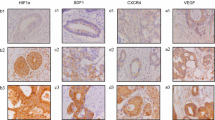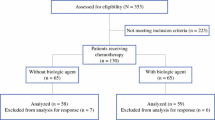Abstract
Introduction
Intraperitoneal (IP) vascular endothelial growth factor (VEGF) levels have been shown to vary in the peritoneal cavity of patients with peritoneal surface malignancies. Our purpose was to correlate levels of IP VEGF with overall and disease-free survival to identify whether IP VEGF can be used to prognosticate patients and the possible role of IP bevacizumab.
Methods
From February to October 2012, 97 consecutive patients with peritoneal carcinomatosis were treated with cytoreductive surgery and hyperthermic intraperitoneal chemotherapy. Intravenous (IV) VEGF levels were taken before surgery, whereas IP VEGF levels were taken at various time points during and after surgery.
Results
Median follow-up was 19.48 months. On univariate analysis, a lower IP VEGF taken just after incision (T1) was associated with improved overall (P = 0.0004) and disease-free survival (P = 0.0006) at 2 years. A lower T1/IV VEGF ratio also was associated with improved overall (P = 0.004) and disease-free survival (P = 0.0051). On multivariate analysis, a lower T1 was associated with improved overall survival, whereas a lower T1/IV VEGF was associated with improved disease-free survival. On subset analysis, these two variables were associated with improved survival in colorectal cancers.
Conclusions
A lower IP VEGF level prior to surgery is associated with improved survival. The use of preoperative intraperitoneal bevacizumab for patients with a heavy disease load should be considered, especially in colorectal cancers.


Similar content being viewed by others
References
Elias D, Goéré D, Dumont F, et al. Role of hyperthermic intraoperative peritoneal chemotherapy in the management of peritoneal metastases. Eur J Cancer. 2014;50(2):332–40.
Passot G, You B, Boschetti G, et al. Pathological response to neoadjuvant chemotherapy: a new prognosis tool for the curative management of peritoneal colorectal carcinomatosis. Ann Surg Oncol. 2014;21(8): 2608–14.
Harmey J. VEGF and cancer. Georgetown: Landes Bioscience/Eurekah.com, Kluwer Academic/Plenum Publishers; 2004; ISBN0-306-47988-5.
Kesterson JP, Mhawech-Fauceglia P, Lele S. The use of bevacizumab in refractory ovarian granulosa-cell carcinoma with symptomatic relief of ascites: a case report. Gynecol Oncol. 2008;111:527–9.
Hamilton CA, Maxwell GL, Chernofsky MR, et al. Intraperitoneal bevacizumab for the palliation of malignant ascites in refractory ovarian cancer. Gynecol Oncol. 2008;111:530–2.
Passot G, Bakrin N, Garnier L, et al. Intraperitoneal vascular endothelial growth factor burden in peritoneal surface malignancies treated with curative intent: the first step before intraperitoneal anti-vascular endothelial growth factor treatment? Eur J Cancer. 2014;50(4):722–30.
Li L, Wang L, Zhang W, et al. Correlation of serum VEGF levels with clinical stage, therapy efficacy, tumor metastasis and patient survival in ovarian cancer. Anticancer Res. 2004;24:1973–9.
Panteix G, Beaujard A, Garbit F, et al. Population pharmacokinetics of cisplatin in patients with advanced ovarian cancer during intraperitoneal hyperthermia chemotherapy. Anticancer Res. 2002;22(2B):1329–36.
Cotte E, Colomban O, Guitton J, et al. Population pharmacokinetics and pharmacodynamics of cisplatinum during hyperthermic intraperitoneal chemotherapy using a closed abdominal procedure. J Clin Pharmacol. 2011;51(1):9–18.
Passot G, Bakrin N, Roux AS, et al. Quality of life after cytoreductive surgery plus hyperthermic intraperitoneal chemotherapy: a prospective study of 216 patients. Eur J Surg Oncol. 2014;40(5):529–35.
Kabbinavar FF, Hambleton J, Mass RD, Hurwitz HI, Bergsland E, Sarkar S. Combined analysis of efficacy: the addition of bevacizumab to fluorouracil/leucovorin improves survival for patients with metastatic colorectal cancer. J Clin Oncol. 2005;23(16):3706–12.
Macedo LT, da Costa Lima AB, Sasse AD. Addition of bevacizumab to first-line chemotherapy in advanced colorectal cancer: a systematic review and meta-analysis, with emphasis on chemotherapy subgroups. BMC Cancer. 2012;12:89.
Burger RA, Brady MF, Bookman MA, et al. Incorporation of bevacizumab in the primary treatment of ovarian cancer. N Engl J Med. 2011;365(26):2473–83.
Pujade-Lauraine E, Hilpert F, Weber B, et al. Bevacizumab combined with chemotherapy for platinum-resistant recurrent ovarian cancer: the AURELIA open-label randomized phase III trial. J Clin Oncol. 2014;32(13):1302–8.
Ranpura V, Hapani S, Wu S. Treatment-related mortality with bevacizumab in cancer patients: a meta-analysis. JAMA. 2011;305(5):487–94.
Scappaticci FA, Fehrenbacher L, Cartwright T, et al. Surgical wound healing complications in metastatic colorectal cancer patients treated with bevacizumab. J Surg Oncol. 2005;91(3):173–80.
Kobold S, Hegewisch-Becker S, Oechsle K, Jordan K, Bokemeyer C, Atanackovic D. Intraperitoneal VEGF inhibition using bevacizumab: a potential approach for the symptomatic treatment of malignant ascites? Oncologist. 2009;14(12):1242–51.
Luo JC, Toyoda M, Shibuya M. Differential inhibition of fluid accumulation and tumor growth in two mouse ascites tumors by an antivascular endothelial growth factor/permeability factor neutralizing antibody. Cancer Res. 1998;58:2594–600.
Ke L, Qu H, Nagy JA, et al. Vascular targeting of solid and ascites tumours with antibodies to vascular endothelial growth factor. Eur J Cancer 1996;32A:2467–73.
Mesiano S, Ferrara N, Jaffe RB. Role of vascular endothelial growth factor in ovarian cancer: Inhibition of ascites formation by immunoneutralization. Am J Pathol. 1998;153:1249–56.
Shaheen RM, Ahmad SA, Liu W, et al. Inhibited growth of colon cancer carcinomatosis by antibodies to vascular endothelial and epidermal growth factor receptors. Br J Cancer. 2001;85:584–9.
Numnum TM, Rocconi RP, Whitworth J, et al. The use of bevacizumab to palliate symptomatic ascites in patients with refractory ovarian carcinoma. Gynecol Oncol. 2006;102:425–8.
El-Shami K, Elsaid A, El-Kerm Y. Open-label safety and efficacy pilot trial of intraperitoneal bevacizumab as palliative treatment in refractory malignant ascites. J Clin Oncol. 2007;25(18 suppl):9043.
Eveno C, Passot G, Goéré D, et al. Bevacizumab doubles the early postoperative complication rate after cytoreductive surgery with hyperthermic intraperitoneal chemotherapy (HIPEC) for peritoneal carcinomatosis of colorectal origin. Ann Surg Oncol. 2014;21(6):1792–800.
Karanlik H, Kurt A, Kunduz E, et al. Effects of intraperitoneal bevacizumab administration on colonic anastomosis and early postoperative adhesion formation. Surg Innov. 2013;20(6):559–65.
Basbug M, Bulbuller N, Camci C, et al. The effect of antivascular endothelial growth factor on the development of adhesion formation in laparotomized rats: experimental study. Gastroenterol Res Pract. 2011;2011:578691.
Ignjatovic D, Aasland K, Pettersen M, et al. Intra-abdominal administration of bevacizumab diminishes intra-peritoneal adhesions. Am J Surg. 2010;200(2):270–5.
Passot G, Dupré A, Rivoire M, Mohamed F, Bakrin N, Glehen O. Intraperitoneal bevacizumab combined with cytoreductive surgery: a pre-clinical study of tolerance and pharmacokinetics in an animal model. Clin Transl Oncol. 2012;14(12):931–6.
Jimenez WA, Sardi A, Ledakis P, Nieroda C, Sittig M, Gushchin V. The role of VEGFR-2 expression in outcomes and survival of patients with peritoneal carcinomatosis from appendiceal cancer. Eur J Surg Oncol. 2013;39(12):1415–22.
Harlozinska A, Sedlaczek P, Kulpa J, et al. Vascular endothelial growth factor (VEGF) concentration in sera and tumor effusions from patients with ovarian carcinoma. Anticancer Res. 2004;24(2C):1149–57.
Acknowledgment
The authors thank Adeline Roux for her contributions to the statistical analysis.
Disclosures
The authors have no financial disclosures or conflict of interests.
Author information
Authors and Affiliations
Corresponding author
Rights and permissions
About this article
Cite this article
Chia, C.S., Glehen, O., Bakrin, N. et al. Intraperitoneal Vascular Endothelial Growth Factor: A Prognostic Factor and the Potential for Intraperitoneal Bevacizumab Use in Peritoneal Surface Malignancies. Ann Surg Oncol 22 (Suppl 3), 880–887 (2015). https://doi.org/10.1245/s10434-015-4644-7
Received:
Published:
Issue Date:
DOI: https://doi.org/10.1245/s10434-015-4644-7




